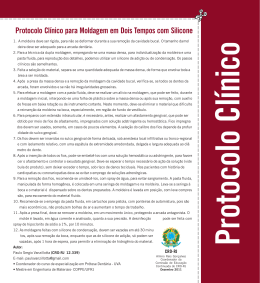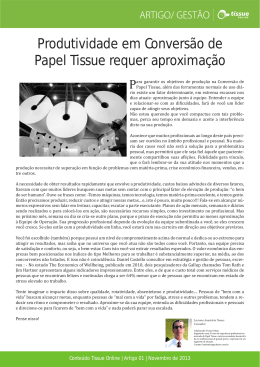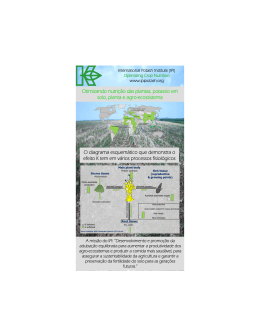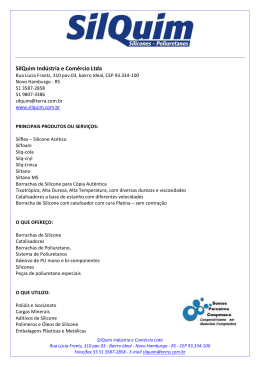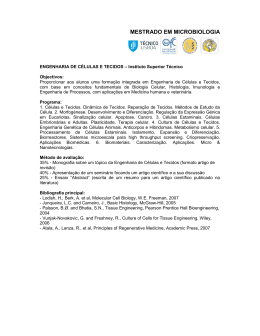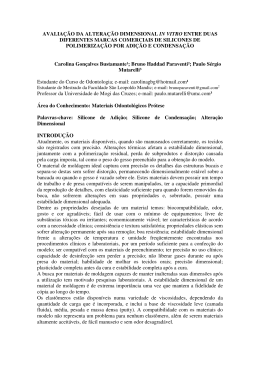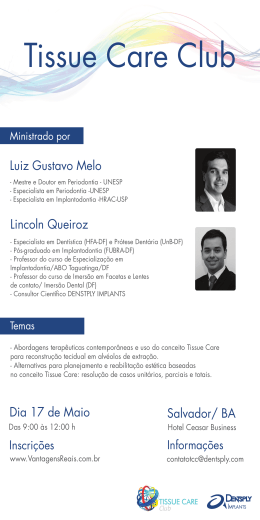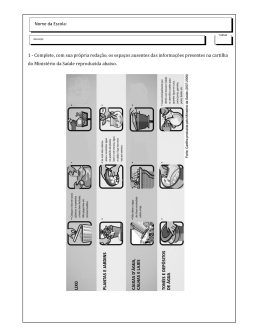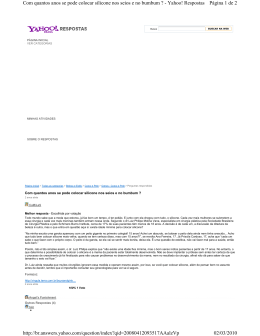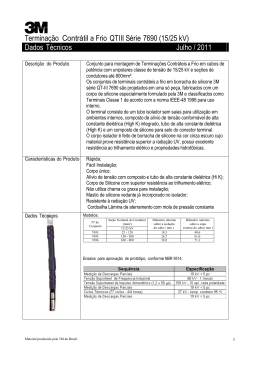Rev Inst Ciênc Saúde 2005 abr-jun; 23(2): 151-5 Uma nova técnica de moldagem funcional para maxilas edentadas com tecido flácido anterior, através de injeção de silicone A new functional impression technique by method of injecting silicone rubber material, proposed for edentate maxillas presenting anterior flabby tissue Atlas Edson Moleros Nakamae* Regina Tamaki* Flávio Augusto Pereira Gomes** Tatiana de Carvalho Guarnieri** Ricardo Jun Furuyama*** Roger Nishyama*** Resumo A retenção antero-posterior de próteses totais para maxilas edentadas, que apresentam tecido flácido anterior, não tem apresentado resultados satisfatórios, independente da técnica de moldagem utilizada. Acreditando ser fundamental eleger uma técnica de moldagem de acordo com as diferentes compressibilidades da mucosa, uma técnica de moldagem funcional foi desenvolvida para maxilas edentadas que apresentam tecido flácido anterior. Após a moldagem preliminar com godiva, são confeccionados um modelo anatômico e uma moldeira individual com câmara de alívio na área correspondente ao tecido flácido. A moldagem é realizada em três passos: 1) A impressão é feita com silicone, objetivando adaptar a moldeira e dela remover qualquer ponto de interferência, deslocando o tecido flácido. 2) A câmara é esvaziada e uma segunda moldagem é realizada, copiando o tecido flácido sem pressão. 3) A câmara é esvaziada uma segunda vez, o molde é adaptado com uma pressão média e nesta condição, o silicone é injetado dentro da câmara, copiando o tecido flácido túrgido. A retenção conseguida com esta técnica alcança um grau satisfatório, uma vez que o silicone injetado reproduz o tecido flácido, que se tornou mais túrgido com a compressão nos tecidos adjacentes e o conseqüente deslocamento de sangue para a região anterior, como ficará quando a prótese for usada fisiologicamente, e não deformado nem em repouso. Palavras-chave: Prótese total – Técnica de moldagem odontológica – Materiais para moldagem odontológica – Perda óssea alveolar Abstract The anteroposterior retention of the denture for edentate maxillas presenting anterior flabby tissue has not been satisfactory, nevertheless the impression technique employed. It is imperative to elect an impression making technique according to different mucosa’s compressibility. A functional impression making technique has been developed for edentate maxillas presenting anterior flabby tissue. After preliminary impression made by compound, a stone cast and an individual tray is made. A block-out over corresponding flabby tissue leads to a chamber of relief of this area. The functional molding is made in three steps. 1) The impression is made with silicone material, aiming to fit the tray and to outline any interference point of the tray, displacing the flabby tissue. 2) The chamber is emptied and a second impression is made, recording the flabby tissue without pressure. 3) The chamber is emptied for the second time, the molding is fitted with mild pressure and in this condition, and silicone material is injected into the chamber, recording the turgid flabby tissue. The retention achieved with this technique meets a satisfactory standard once the silicone rubber material injected reproduces the flabby tissue, which becomes more turgid under the compression of the circa-adjacent tissues. This fulfillment arises from the blood flow pressure into the flabby tissue (anterior area). This technique focuses on the anteroposterior retention of the upper denture. This kind of retention is achieved not from recording the flabby tissue on a deformed condition nor from a rest one, but primarily by the fact that the flabby tissue is reproduced in a turgid form, such as it becomes as the denture will be physiologically used. Key words: Complete denture – Dental impression technique – Dental impression materials – Alveolar bone loss * Professor(a) Doutor(a) da Disciplina de Prótese Total do Departamento de Prótese da Faculdade de Odontologia da Universidade de São Paulo (FOUSP). E-mail:[email protected] ** Aluno(a) de Pós-Graduação, nível Doutorado, do Departamento de Prótese da FOUSP. *** Aluno de Pós-Graduação, nível Mestrado, do Departamento de Prótese da FOUSP. 152 Introdução Estudos realizados com pacientes edentados superiores e parcialmente edentados inferiores, que foram reabilitados com próteses totais e próteses parciais removíveis, respectivamente, indicam que 24% destes apresentam características similares8 como a perda óssea anterior do processo alveolar superior, extrusão das tuberosidades maxilares, assim como dos dentes anteriores inferiores, hiperplasia papilar no palato duro e reabsorção óssea sob a base das próteses parciais removíveis. De acordo com Thiel et al.8 (1996), a expressão “Síndrome da Combinação” é usada para descrever a convergência destes achados, os quais também são encontrados em pacientes com próteses totais superiores e próteses totais implanto-retidas (overdentures)10. Esta situação conduz a um aumento na força funcional dos contatos anteriores e pode causar reabsorção do processo alveolar ântero-superior, o que torna a área da mucosa espessa e flácida, permitindo movimentos laterais e a conseqüente perda de retenção, principalmente na área do selado posterior. Há numerosas opções para resolver o problema, mas todas elas envolvem o desenvolvimento de um esquema oclusal que proteja a região maxilar anterior da pressão excessiva em oclusão cêntrica e habitual. Tecidos fibromucosos sem movimentos tangenciais podem ser parcialmente comprimidos, dentro de um limiar biológico, para permitir uma grande eficiência mastigatória em uma contração muscular isométrica. Outra vantagem desta compressão fisiológica é a grande estabilidade da prótese durante a função. Por outro lado, estes tecidos apresentam movimentos tangenciais que podem ser aliviados1, 3-5,7,9,11,13, para não sofrerem deformação. Fatores externos como o desenho da moldeira e o material selecionado, podem controlar a pressão durante a moldagem3-12. Isto é demonstrado por uma técnica de moldagem em dois passos para mucosas altamente flácidas e deslocáveis5: uma janela na moldeira individual envolve todos os tecidos e, após a impressão fisiológica das bordas usando godiva de impressão tipo I e o restante da moldeira coberta usando pasta de óxido de zinco-eugenol, toda a pasta extravasada pela janela é removida para permitir a aplicação de gesso de impressão sobre a mucosa com uma espátula. Desta forma, é obtida uma moldagem estática do tecido flácido e móvel. Outros materiais podem substituir a pasta de óxido de zinco-eugenol, como o silicone e a mercaptana, que tem características de moldagem idênticas, embora mais caros. Quando uma prótese total superior oclui com dentes anteriores inferiores por um longo período, devido à ausência de suporte posterior, a dissipação da pressão na região anterior promove uma excessiva reabsorção da crista do osso alveolar, levando à sua substituição por tecido mole. Em resposta à distribuição imprópria da carga oclusal, ocorre uma ruptura do selamento, seguida pela perda de retenção. Conseqüentemente, é fundamental eleger uma técnica de moldagem que permita variações de acordo com a compressibilidade da mucosa. Para cumprir este requisito, uma técnica de moldagem funcional foi desenvolvida para maxilas edentadas que apresentam tecido flácido anterior, e será apresentada a seguir. Métodos Previamente à descrição da técnica de moldagem funcional, é explicada a moldagem anatômica, devido ao fato de que do modelo obtido dessa moldagem é que se origina a moldeira individual, usada na moldagem funcional apresentada. A técnica utilizada é a preconizada pela Disciplina de Prótese Total da Faculdade de Odontologia da Universidade de São Paulo – Universidade de São Paulo (FOUSP), que utiliza godiva de impressão tipo II em placas conduzidas a um banho de água a 60°C. Quando o material é uniformemente plastificado, é disposto na moldeira previamente selecionada de maneira a cobrir todas as bordas e é levado centralizado à boca do paciente. Então, é feita uma compressão simultânea, seguida de uma tração de lábios e bochechas. O molde é removido, lavado em água fria, seco e analisado (Figura 1). Se aprovado, é preenchido com gesso tipo II (100g de gesso para 50 cc de água) sobre vibração. Após a cristalização do gesso, o modelo de estudo é removido em água quente (± 60°C) e convenientemente recortado e delimitado usando um lápis cópia. Para limitar a cobertura da prótese que representa a área envolvida pela futura prótese, é importante reconhecer algumas estruturas anatômicas como o freio labial superior e as inserções dos músculos bucinadores, que devem ser contornados de forma a evitar o deslocamento da moldeira pela sua contração. Uma linha de 3 a 4 mm abaixo da inserção da fibromucosa móvel é unida à linha previamente contornada e contínua para a parte posterior onde envolve as tuberosidades maxilares. O último passo é traçar uma linha a 2 mm sobre o palato mole. A porção anterior, correspondente ao tecido flácido, também é delimitada para posteriormente ser feito um alívio (Figura 2). Para fazer a moldeira individual, é utilizado o método proposto pela Disciplina de Prótese Total da FOUSP. O modelo de estudo é aliviado com cera rosa nº 7, tornandose expulsivo o suficiente para permitir a remoção da moldeira sem danificá-lo. A muralha anterior pode ser feita com a mesma cera (Figura 3) e então o modelo está pronto para receber uma fina camada de isolante para resina. Manipula-se a resina acrílica (15 cc de pó de resina acrílica auto-polimerizável incolor, saturada pelo líquido da resina acrílica auto-polimerizável, em um recipiente de vidro), espera-se pela fase plástica e o material é disposto sobre o modelo com uma espátula nº 36 e com o dedo indicador molhado no monômero, de maneira a obter uma espessura uniforme de ± 2 mm. Um cabo medindo 1 x 0,5 x 1 cm (largura x espessura x altura) é adaptado sobre a região anterior, na linha média, com uma inclinação de 60° para o lado vestibular (Figura 4). Uma vez terminado o processo de polimerização, a moldeira é recortada com fresas para resina acrílica e Nakamae AEM, Tamaki R, Gomes FAP, Guarnieri T de C, Furuyama RJ, Nishyama R. Uma nova técnica de moldagem funcional para maxilas edentadas com tecido flácido anterior, através de injeção de silicone. Rev Inst Ciênc Saúde 2005 abr-jun; 23(2):151-5. 153 Figura 1. Moldagem anatômica Figura 2. Delimitação da cobertura da prótese e dos tecidos moles Figura 3. Bloqueio de cera na região correspondente do tecido mole anterior Figura 4. Moldeira individual em resina acrílica com a muralha de cera Figura 5. Primeira camada de silicone de condensação Figura 6. Pronta para carregar a segunda camada para moldagem Nakamae AEM, Tamaki R, Gomes FAP, Guarnieri T de C, Furuyama RJ, Nishyama R. Uma nova técnica de moldagem funcional para maxilas edentadas com tecido flácido anterior, através de injeção de silicone. Rev Inst Ciênc Saúde 2005 abr-jun; 23(2):151-5. 154 Figura 7. Injeção de silicone de condensação através da perfuração palatina da moldeira individual Figura 8. Técnica de moldagem funcional através da injeção de silicone concluída polida com tiras abrasivas nº 120 montadas em um mandril para peça de mão. Então, posiciona-se a moldeira na boca do paciente, ajustando-a cuidadosamente, procurando por eventuais pontos que podem causar injúrias à mucosa, visualizando também áreas isquêmicas, que podem impedir a correta adaptação da moldeira. Após os ajustes necessários, a moldeira de resina acrílica pode receber uma camada de adesivo sobre toda a sua extensão interna e 0,5 cm na sua superfície externa, de modo que haja adesão do material de impressão à moldeira. A moldagem utilizando silicone é realizada em três passos: o primeiro serve para ajustar a moldeira ao rebordo; o segundo, para concluir a moldagem do mesmo; e o terceiro, para reproduzir o tecido flácido por injeção. Moldagem funcional: 1) Manipulam-se dez centímetros de pasta base (silicone de condensação) com a mesma quantidade de pasta catalisadora (pasta ativadora para silicone de condensação) até que seja alcançado um estado uniforme. Dispensa-se o material dentro da moldeira e leva-se à boca. Mantendo dois dedos (dedos indicador e médio) na região de pré-molares, uma pressão bilateral e uniforme permite o escoamento. A moldeira deve ser mantida no lugar e, momentos antes da presa, determinada clinicamente quando o material não mais gruda na luva, mas ainda pode ser modelado, inicia-se a tração dos lábios com o objetivo de reproduzir o seu selado periférico. Após a cura, remove-se a moldagem da boca e são feitos os desgastes necessários na resina utilizando-se brocas nas áreas sem silicone, as quais expõem sobre-extensões da moldeira (Figura 5); 2) pincelar uma nova camada de adesivo nos pontos falhos e, utilizando-se um instrumento afiado, remover o material correspondente à região anterior, incluindo a muralha de cera (Figura 6). Cuidadosamente, procede-se às perfurações com broca esférica de metal nº 8 para peça de mão, uma no lado vestibular da região anterior com o objetivo de permitir a injeção do material, e outra no lado palatino para permitir o escoamento e assim diminuir a pressão sobre o tecido flácido2,6.7.9.13. Ambas as perfurações podem ser obstruídas com cera utilidade e a moldeira pode ser carregada novamente com dez centímetros de cada pasta do material de moldagem elástico, repetindo os procedimentos descritos para a primeira moldagem. Remove-se o material da região anterior e as ceras das perfurações e mantémse a moldeira assentada sobre o rebordo com alguma pressão a fim de deixar o tecido flácido mais túrgido; 3) Com a ajuda de uma seringa plástica para impressão, injetam-se 5 centímetros de silicone pela perfuração palatina, enquanto o silicone flui pela perfuração vestibular (Figura 7). Neste passo, o silicone injetado reproduz o tecido flácido, que se torna mais túrgido com a compressão dos tecidos adjacentes. Esta condição resulta da pressão causada pelo fluxo sanguíneo para o tecido flácido (região anterior) (Figura 8). Conclusão Esta técnica não incorre em riscos para o paciente e para a equipe. As dificuldades são a sua complexibilidade e a habilidade necessária para ser realizada. Outro aspecto negativo a ser apontado é o tempo de trabalho maior, e conseqüentemente o aumento de custo. Sua contribuição mais importante da técnica é o aumento da retenção ântero-posterior da prótese superior, já que estes casos de tecido flácido anterior desafiam ainda hoje os protesistas. Nakamae AEM, Tamaki R, Gomes FAP, Guarnieri T de C, Furuyama RJ, Nishyama R. Uma nova técnica de moldagem funcional para maxilas edentadas com tecido flácido anterior, através de injeção de silicone. Rev Inst Ciênc Saúde 2005 abr-jun; 23(2):151-5. 155 Referências 1. Bolouri A, McKinney TW. Two-stage impression making for complete dentures over loose mobile supporting tissues. Compend Cont Educ Dent 1989; 10(4): 196-200. 8. Kelly E. Changes caused by a mandibular removable partial denture opposing a maxillary complete denture. J Prosthet Dent 1972; 27: 14050. 2. Collet HA. Final impressions for complete dentures. J Prosthet Dent 1970; 23(3): 250-64. 9. Klein IE, Broner AS. Complete denture secondary impression technique to minimize distortion of ridge and border tissues. J Prosthet Dent 1985; 54(5):660-4. 3. Frank RP. Analysis of pressures produced during maxillary edentulous impression procedures. J Prosthet Dent 1969; 4: 400-13. 4. Frank RP. Controlling pressures during complete denture impressions. Dent CIin North Am 1970; 14: 453-70. 5. Hobkirk JA. A colour atlas of complete dentures. Netherlands: Wolfe; 1985. p. 15-29. 6. Jamieson CH. A Complete denture impression technique. J Prosthet Dent 1954; 4: 17-29. 7. Kawabe S. Kawabe’s complete dentures. St Louis: Ishiyaku Euroamerica; 1992. p. 15-35. 10. Thiel CP, Evans DB, Burnett RR. Combination syndrome associated with a mandibular implantsupported overdenture: a clinical report. J Prosthet Dent 1996; 75: 107-13. 11. Tucker KM. Relining complete dentures with the use of a functional impression. J Prosthet Dent 1966; 16: 1054-7. 12. Weng BX, Khlevnoy V. Pressure control for denture impressions. Oral Health 1995; 85(11):21-7. 13. Wolff JL. Dual impression technique for complete dentures. Dent Survey 1975; 51(2): 24-8. Recebido em 16/9/2004 Aceito em 13/12/2004 Nakamae AEM, Tamaki R, Gomes FAP, Guarnieri T de C, Furuyama RJ, Nishyama R. Uma nova técnica de moldagem funcional para maxilas edentadas com tecido flácido anterior, através de injeção de silicone. Rev Inst Ciênc Saúde 2005 abr-jun; 23(2):151-5. Rev Inst Ciênc Saúde 2005 abr-jun; 23(2): 157-61 A new functional impression technique by method of injecting silicone rubber material, proposed for edentate maxillas presenting anterior flabby tissue Atlas Edson Moleros Nakamae* Regina Tamaki* Flávio Augusto Pereira Gomes** Tatiana de Carvalho Guarnieri** Ricardo Jun Furuyama*** Roger Nishyama*** Abstract The anteroposterior retention of the denture for edentate maxillas presenting anterior flabby tissue has not been satisfactory, nevertheless the impression technique employed. It is imperative to elect an impression making technique according to different mucosa’s compressibility. A functional impression making technique has been developed for edentate maxillas presenting anterior flabby tissue. After preliminary impression made by compound, a stone cast and an individual tray is made. A block-out over corresponding flabby tissue leads to a chamber of relief of this area. The functional molding is made in three steps. 1) The impression is made with silicone material, aiming to fit the tray and to outline any interference point of the tray, displacing the flabby tissue. 2) The chamber is emptied and a second impression is made, recording the flabby tissue without pressure. 3) The chamber is emptied for the second time, the molding is fitted with mild pressure and in this condition, and silicone material is injected into the chamber, recording the turgid flabby tissue. The retention achieved with this technique meets a satisfactory standard once the silicone rubber material injected reproduces the flabby tissue, which becomes more turgid under the compression of the circa-adjacent tissues. This fulfillment arises from the blood flow pressure into the flabby tissue (anterior area). This technique focuses on the anteroposterior retention of the upper denture. This kind of retention is achieved not from recording the flabby tissue on a deformed condition nor from a rest one, but primarily by the fact that the flabby tissue is reproduced in a turgid form, such as it becomes as the denture will be physiologically used. Key words: Complete denture – Dental impression technique – Dental impression materials – Alveolar bone loss Introduction Studies regarding superior edentate and inferior partial edentate patients, who where rehabilitated by complete dentures and removable partial prostheses, respectively, indicated that 24% presented similar characteristics 8 such as anterior bone loss of the superior alveolar process, extrusion of maxillary tuberosities, as well as the anteroinferior teeth, papillary hyperplasia on the hard palate and bone resorption under the removable partial prostheses’ bases. According to Thiel et al. 8 (1996), the phrase "Combination Syndrome" is used to describe the convergence of these ailments. These ailments are also found in superior complete denture and inferior implant-supported overdenture users11. This situation leads to an increase in the force of anterior functional c o n ta ct s , a n d can caus e resorption of the anterosuperior alveolar process, which makes the area’s mucosa thick and flaccid, allowing lateral movement and consequent retention loss, mainly of the post dam area. There are numerous options to solve this problem, but all of them involve the development of an occlusal scheme that protects the anterior maxillary region from excessive pressure in both centric and habitual positions. Fibro mucosal tissues without tangential movements may be partially compressed in a biologic threshold to enable greater masticator efficiency in an isometric muscular contraction. Another advantage of this physiologic compression is the greater stability of the prosthesis during function. On the other hand, those tissues presenting tangential movements must be relieved1,3-5,7,9,11,13, in order to not become deformed. Outer factors such as the tray’s design and the material selected can control the pressure during the impression making3,12. This is demonstrated by a twosteps impression making technique for highly flabby and displaceable mucosa5: a window in the individual tray involves all this tissue and, after the physiologic impression of the borders using type I impression * PhD, Professor, Discipline Complete Denture, School of Dentistry, Universidade de São Paulo (USP). E-mail: [email protected] ** Graduate Student, Doctor’s Degree, Discipline Complete Denture, School of Dentistry, USP. *** Graduate Student, Master’s Degree, Discipline Complete Denture, School of Dentistry, USP. 158 compound and the rest of the denture coverage using zinc oxide-eugenol paste, all of the outer paste through the window is removed in order to allow the application of impression plaster over the mucosa with a spatula. Therefore, a static impression of the flabby and moveable tissue is obtained. Other materials can be used to replace the zinc oxide-eugenol paste, such as silicone and mercaptan, which have identical impression characteristics, although more expensive. When a superior complete denture occludes with anteroinferior natural teeth for a long period, due to the absence of posterior support, the load dissipation on the anterior region promotes an excessive resorption of the alveolar bone crest, leading to its replacement by soft tissue. In response to the non-proper distribution of the occlusive load, a rupture of the sealing occurs followed by a retention loss. Hence, it is imperative to elect an impression making technique that allows variations according to the mucosa’s compressibility. To accomplish this requirement, a functional impression making technique has been developed for edentate maxillas presenting anterior flabby tissue, as follows. Methods Prior to the description of the functional impression making technique itself, it is primary to explain the anatomic one, due to the fact that the model obtained by this impression originates the individual tray used for the functional impression making as to be presented. The technique adopted is the pre-cognized by Complete Denture Discipline of the FOUSP (Faculdade de Odontologia da Universidade de São Paulo), which utilizes type II impression compound in plates taken to the compound water bath heater half-filled of water at 60°C. When the material is uniformly softened, it is disposed over the previously selected tray in a manner to cover all borders, while taken into the patient’s mouth centralized. Then, a simultaneous bilateral compression is carried out, followed by a lips’cheeks’ traction. The impression is then removed, washed in cold water, dried and analyzed (Figure 1). If approved, the impression is filled with plaster type II (100 g of plaster to 50 cc of water) under vibration. After plaster crystallization, the study cast is removed in hot water (± 60°C) and conveniently trimmed and delimited using the ink pencil. For limiting the denture coverage that represents the area involved by the future prosthesis, it is important to recognize anatomic structures such as the superior lip frenum and the buccinator muscle insertion, which must be contoured in order to avoid the displacement of the tray by their contractions. A 3 to 4 mm line beyond the insertion of the moveable fibromucosa links the previous contoured lines and continues to the posterior portion, where it involves the maxillary tuberosity. The last step is to trace a line that goes 2 mm over soft palate. The anterior portion, corresponding to the flabby tissue, is also delimited to be later blocked out (Figure 2). To make the individual tray, the method proposed by the Complete Denture Discipline of the FOUSP, is described in the sequence. The study cast has to be relieved with rose wax nº 7 to become expulsive enough to allow the removal of the tray without damaging it. The anterior block-out must be made with this same wax (Figure 3) and then the cast is ready to receive a thin layer of separating film. Manipulate the acrylic resin (15 cc of auto-polymerizing acrylic material colorless ponder Jet, saturated by auto-polymer acrylic resin liquid Jet in a glass recipient), wait for the plastic phase and dispose the material over the cast with a spatula nº 36 and the forefinger wet in monomer, in a manner to get an uniform thickness of ± 2 mm. A handle string measuring 1 X 0.5 X 1 cm (largeness X thickness X width) is adapted over the anterior region, in the median line, in a 60° inclination to the vestibule side (Figure 4). Once the polymerization process is over, the tray is cut by freesias for acrylic and polished by abrasive strips nº 120 held by mandrel for air turbine hand piece. Firstly, place the tray into patient’s mouth and carefully adjust, searching for eventual points that might injure the mucosa, visualized as ischemic areas, which might even disable the individual tray correct fitting. After the necessary adjusts, the acrylic tray must receive a layer of adhesive all over its inner portion and 0.5 cm on the outer surface, in order to enable the adhesion of the impression material to the tray. The impression using silicone rubber is carried out in three steps: the first serves to adjust the tray to the ridge; the second, to conclude the impression making itself; and the third, to reproduce the flabby tissue by injection. Functional Impression: 1) ten centimeters of the base paste (condensation silicone rubber) must be manipulated with the same quantity of the catalyst paste (activator paste for condensation silicone) until an even state is achieved. Dispose the material inside the tray and take it into the mouth. Maintaining two fingers (forefinger and medium) on the premolar region, a bilateral firm and uniform pressure allows draining. The tray must be kept in place and, a few moments before the cure (clinically, once the material is no longer attached to the gloves), but where it still can be modeled, initiate the lips’ cheeks’ traction in order to reproduce its peripheral seal. After cure, remove the impression from the mouth and make the necessary resin wearing using burs in the areas without silicone, stating the tray overextension (Figure 5); 2) brush a new adhesive layer on the frayed points and, using a sharp instrument, remove the material corresponding to the anterior region, including the wax block-out (Figure 6). Carefully proceed with two perforations using steel aspheric bur nº 8 for air turbine hand piece, one on the vestibule side of the anterior area in order to allow the injection of the material, and another one on the lingual to allow draining, decreasing the pressure over the flabby tissue2,6,7,9,13. Both of them must be tapped with utility wax and the tray must be once again carried with ten centimeters of each paste of the impression rubber material, repeating the Nakamae AEM, Tamaki R, Gomes FAP, Guarnieri T de C, Furuyama RJ, Nishyama RA New functional impression technique by method of injecting silicone rubber material, proposed for edentate maxillas presenting anterior flabby tissue. Rev Inst Ciênc Saúde 2005 abr-jun; 23(2):157-61. 159 Figure 1. Anatomic impression making Figure 2. Delimitation of denture coverage and soft tissue Figure 3. Wax block-out in region corresponding to anterior soft tissue Figure 4. Individual tray in acrylic resin with anterior wax block-out Figure 5. First layer of condensation silicone rubber material Figure 6. Ready to carry out second layer of impression making Nakamae AEM, Tamaki R, Gomes FAP, Guarnieri T de C, Furuyama RJ, Nishyama RA New functional impression technique by method of injecting silicone rubber material, proposed for edentate maxillas presenting anterior flabby tissue. Rev Inst Ciênc Saúde 2005 abr-jun; 23(2):157-61. 160 Figure 7. Injection of condensation silicone rubber material through palatine hole of individual tray procedures described for the first impression making. Remove both the anterior area material and the wax of the perforations and correctly fit the tray over the ridge under some pressure in order to let the flabby tissue become more turgid, and 3) with the help of a plastic impression syringe, inject five centimeters of the silicone through the palatine hole until it overflows through the vestibule one (Figure 7). In this step, the silicone rubber material injected reproduces the flabby tissue, which becomes more turgid under the compression of the circa-adjacent tissues. This turgidity/fulfillment arises from the blood flow pressure into the flabby tissue (anterior area). This impression is produced by keeping the anterior area into a tray chamber, feasible due to a wax block-out over this area (Figure 8). Figure 8. Functional impression making technique throughout injection of silicone rubber material concluded Conclusion This technique does not incur in risks either for the patients or for the staff. The difficulties are the complexity and the skills required to be played. Another negative aspect to be pointed out is the longer time spent, and the consequent increased costs. The technique’s most important contribution is the anteroposterior retention of the upper denture, enabled by the fact that the flabby tissue is reproduced in the way it will be physiologically used. The tissue turgidity has been ignored over the time, making the cases involving anterior flabby tissue a main challenge for the prosthodontists up to now. References 1. Bolouri A, McKinney TW. Two-stage impression making for complete dentures over loose mobile supporting tissues. Compend Cont Educ Dent 1989; 10(4): 196-200. 2. Collet HA. Final impressions for complete dentures. J Prosthet Dent 1970; 23(3): 250-64. 3. Frank RP. Analysis of pressures produced during maxillary edentulous impression procedures. J Prosthet Dent 1969; 4: 400-13. 4. Frank RP. Controlling pressures during complete denture impressions. Dent CIin North Am 1970; 14: 453-70. 5. Hobkirk JA. A colour atlas of complete dentures. Netherlands: Wolfe; 1985. p. 15-29. 6. Jamieson CH. A Complete denture impression technique. J Prosthet Dent 1954; 4: 17-29. 7. Kawabe S. Kawabe’s complete dentures. St Louis: Ishiyaku Euroamerica; 1992. p. 15-35. 8. Kelly E. Changes caused by a mandibular removable partial denture opposing a maxillary complete denture. J Prosthet Dent 1972; 27: 14050. Nakamae AEM, Tamaki R, Gomes FAP, Guarnieri T de C, Furuyama RJ, Nishyama RA New functional impression technique by method of injecting silicone rubber material, proposed for edentate maxillas presenting anterior flabby tissue. Rev Inst Ciênc Saúde 2005 abr-jun; 23(2):157-61. 161 9. Klein IE., Broner AS. Complete denture secondary impression technique to minimize distortion of ridge and border tissues. J Prosthet Dent 1985; 54(5):660-4. 10. Thiel CP, Evans DB, Burnett RR. Combination syndrome associated with a mandibular implantsupported overdenture: a clinical report. J Prosthet Dent 1996; 75: 107-13. 11. Tucker KM. Relining complete dentures with the use of a functional impression. J Prosthet Dent 1966; 16: 1054-7. 12. Weng BX, Khlevnoy V. Pressure control for denture impressions. Oral Health 1995; 85(11):21-7. 13. Wolff JL. Dual impression technique for complete dentures. Dent Survey 1975; 51(2): 24-8. Received in 16/9/2004 Accepted in 13/12/2004 Nakamae AEM, Tamaki R, Gomes FAP, Guarnieri T de C, Furuyama RJ, Nishyama RA New functional impression technique by method of injecting silicone rubber material, proposed for edentate maxillas presenting anterior flabby tissue. Rev Inst Ciênc Saúde 2005 abr-jun; 23(2):157-61.
Download
